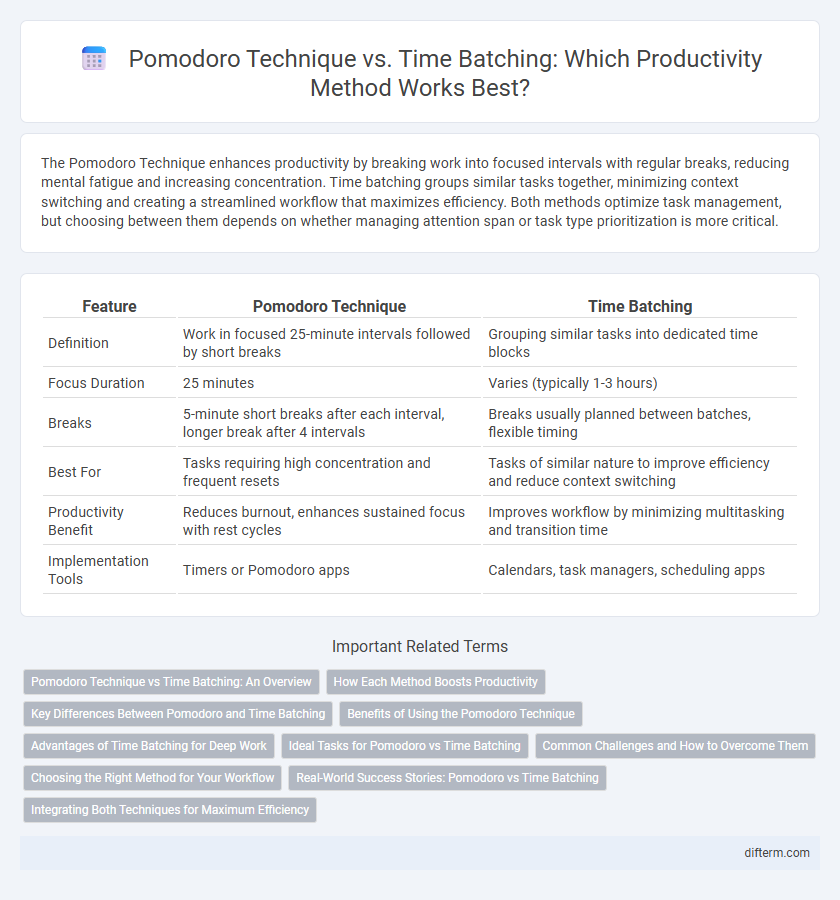The Pomodoro Technique enhances productivity by breaking work into focused intervals with regular breaks, reducing mental fatigue and increasing concentration. Time batching groups similar tasks together, minimizing context switching and creating a streamlined workflow that maximizes efficiency. Both methods optimize task management, but choosing between them depends on whether managing attention span or task type prioritization is more critical.
Table of Comparison
| Feature | Pomodoro Technique | Time Batching |
|---|---|---|
| Definition | Work in focused 25-minute intervals followed by short breaks | Grouping similar tasks into dedicated time blocks |
| Focus Duration | 25 minutes | Varies (typically 1-3 hours) |
| Breaks | 5-minute short breaks after each interval, longer break after 4 intervals | Breaks usually planned between batches, flexible timing |
| Best For | Tasks requiring high concentration and frequent resets | Tasks of similar nature to improve efficiency and reduce context switching |
| Productivity Benefit | Reduces burnout, enhances sustained focus with rest cycles | Improves workflow by minimizing multitasking and transition time |
| Implementation Tools | Timers or Pomodoro apps | Calendars, task managers, scheduling apps |
Pomodoro Technique vs Time Batching: An Overview
The Pomodoro Technique structures work into focused 25-minute intervals separated by short breaks, enhancing concentration and reducing burnout. Time batching groups similar tasks together for extended periods, minimizing context switching and boosting efficiency. Both methods optimize productivity by managing attention and energy but cater to different work styles and task complexities.
How Each Method Boosts Productivity
The Pomodoro Technique boosts productivity by breaking work into 25-minute focused intervals separated by short breaks, enhancing concentration and preventing burnout. Time batching groups similar tasks into dedicated time blocks, reducing task-switching and increasing efficiency. Both methods optimize workflow by fostering sustained focus and minimizing distractions, leading to higher task completion rates.
Key Differences Between Pomodoro and Time Batching
The Pomodoro Technique breaks work into focused 25-minute intervals with short breaks, promoting intense concentration and frequent rest to maintain productivity. Time batching groups similar tasks into larger, uninterrupted blocks to minimize context switching and enhance workflow efficiency. Key differences lie in interval length, break frequency, and task organization, with Pomodoro emphasizing time increments and Time batching prioritizing task similarity.
Benefits of Using the Pomodoro Technique
The Pomodoro Technique enhances productivity by breaking work into focused, 25-minute intervals, boosting concentration and minimizing burnout. Short breaks between sessions help maintain mental agility and reduce fatigue, leading to sustained high performance. This method's structured timing fosters better time management and increases accountability in task completion.
Advantages of Time Batching for Deep Work
Time batching enhances deep work by grouping similar tasks into dedicated blocks, reducing cognitive switching and increasing focus intensity. This method minimizes distractions and optimizes mental energy, leading to sustained concentration and higher-quality output over longer periods. Compared to the Pomodoro Technique, time batching better supports complex projects requiring uninterrupted attention and deep problem-solving.
Ideal Tasks for Pomodoro vs Time Batching
The Pomodoro Technique is ideal for tasks requiring sustained focus and frequent breaks, such as writing, coding, or studying, where short bursts of concentrated effort enhance productivity. Time batching excels with similar or repetitive tasks like email management, meetings, or administrative work, optimizing workflow by grouping related activities to minimize context switching. Selecting Pomodoro is beneficial for attention-intensive tasks, while time batching suits tasks benefiting from extended, uninterrupted periods of a single activity type.
Common Challenges and How to Overcome Them
Common challenges in using the Pomodoro Technique and Time Batching include difficulty maintaining consistent focus and managing distractions during work intervals. Overcoming these obstacles involves setting clear objectives for each session, using apps or timers to enforce breaks, and creating a distraction-free environment to enhance concentration. Regularly reviewing and adjusting time blocks based on workload and energy levels optimizes productivity and reduces burnout.
Choosing the Right Method for Your Workflow
Choosing the right productivity method depends on your workflow's demands and task nature. The Pomodoro Technique suits tasks requiring short bursts of intense focus with regular breaks, enhancing concentration and preventing burnout. Time batching works best for grouping similar tasks, minimizing context switching, and maximizing efficiency during extended work periods.
Real-World Success Stories: Pomodoro vs Time Batching
Real-world success stories highlight the Pomodoro Technique's effectiveness in boosting focus through 25-minute work sprints, widely used by software developers and writers to reduce burnout and maintain consistent productivity. Time batching excels in roles like project management and content creation, allowing professionals to group similar tasks, which minimizes context switching and enhances workflow efficiency. Both methods have demonstrated significant productivity improvements, with users often customizing the techniques to fit specific industry demands and personal work rhythms.
Integrating Both Techniques for Maximum Efficiency
Integrating the Pomodoro Technique with time batching enhances productivity by combining focused work intervals with strategic task grouping, reducing cognitive switching costs. Utilizing 25-minute Pomodoro sessions within larger time batches allows for sustained concentration while efficiently managing similar tasks, maximizing output. This hybrid approach leverages the strengths of both methods to optimize time management and maintain high energy levels throughout the workday.
Pomodoro Technique vs Time batching Infographic

 difterm.com
difterm.com